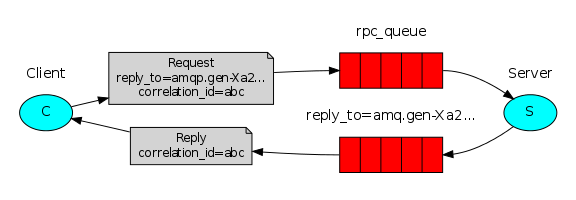在第二小节,我们学习了如何使用 Work Queues 将耗时的任务分发到多个 worker 处理。
但是,当我们需要在远程机计算机上运行一个函数,之前的例子就无法满足了。这种模式一般被称为 远程方法调用(Remote Procedure Call or RPC)。
在这一节,我们将使用 RabbitMQ 来构建一个 RPC 系统:一个客户端和一个可伸缩的 RPC 服务器。因为我们没有耗时的任务需要分布式计算,所以我们将创建一个虚构的 RPC Server 来返回 斐波那契数据列。
客户端接口(Client interface)
为了阐明 RPC 服务器 是如何工作的,我们将创建一个简单的客户端类。它暴露一个叫 call 的方法,用来发送 RPC 请求并阻塞直到收到应答。
|
|
使用 RPC 需要注意
虽然 RPC巴拉巴拉
回调队列(Callback queue)
一般情况下在 RabbitMQ 中进行 RPC 调用是很简单的。客户端发送请求消息(request ),服务器回复消息(response )。为了能够收到 response ,我们需要在发送的 request 中包含一个回调(Callback )队列地址。我们可以使用默认的队列(在 Java 客户端中的独占的)。
|
|
消息的属性(Message properties)
AMQP 0-9-1 协议预定义了消息的 14个属性。大多数属性很少用到,除了以下几个:
deliveryMode :标识一个消息是持久化(persistent 使用值 2)或者瞬态(transient 任意其他值)。你也许还记得第二节使用到了这个属性。
contentType : 用于描述编码的 mime-type 。例如常用的 JSON 编码就是一个很好的例子,需要将值设置为 application/json 。
replyTo : 一般用于命名回调队列。
correlationId : 对于创建一个和 request 对应的 RPC response 很有帮助。
Correlation Id
上面呈现的方法需要为每一个 RPC 请求创建一个回调队列。这种做法其实很低效,幸运的是有一种更好的方法 —— 每一个客户端只创建一个回调队列。
这又引发了一个新问题,队列收到了回复,但是却不知道这个回复属于哪个请求。这时候就需要用到 CorrelationId 属性了。我们将为每一个请求发送一个唯一的值,基于这点,就可以将回复和请求匹配起来。如果我们收到一个未知的 CorrelationId 值,我们可以安全的丢弃 —— 它不属于任何一个请求。
为什么要忽略回调队列中的未知的消息而不是返回一个错误呢?因为在很偶然的情况下,RPC server 在向客户端发送应答之后,但是在发送 ack 确认消息之前宕机了。这样 RPC server 回复后将再次处理请求。这即使为什么客户端需要优雅地处理重复的 response,RPC server 在理想状况下是幂等的。
总结

我们设计的 RPC 是这样工作的:
- 客户端启动时,它将创建一个匿名独占的回调队列。
- 开始一个 RPC 请求,客户端发送一个消息包含两个属性:replyTo ,用于记录回调队列,以及correlationId 用于为每一个请求标记唯一值。
- 请求会发送到一个叫 rpc_queue 的队列。
- RPC worker 监听 rpc_queue 队列等待请求。当请求出现时,它完成工作并使用 replyTo 域记录的队列将结果发送回客户端。
- 客户端等待回调队列的数据。当消息出现时,它将检查 correlationId 属性,如果和请求的 correlationId 值匹配,就将响应 response 返回给应用程序。
合并代码
RPCClient.java
|
|
RPCServer.java
|
|
运行结果
|
|
|
|
客户端代码轻微涉及到:
- 客户端建立connection、channel 并为回复定义一个独占的 ‘callback’ queue。
- 客户端订阅 ‘callback’ queue,这样就能接收到 RPC server 的响应。
- call 方法发送 RPC 请求。
- 首先生成一个唯一的 correlationId 并保存下来 —— DefaultConsumer 的 handleDelivery 实现将使用这个值来捕获适当的响应。
- 接着我们发布请求消息,包含两个属性:replyTo 和 correlationId。
- 此时,等待合适的响应到达。
- 因为消费者处理消息是在单独的线程中的,在响应到达之前,我们需要一种机制来挂起主线程。BlockingQueue 的使用是一种解决方法。我们创建一个 capacity 为1 的 ArrayBlockingQueue 来等待唯一的响应。
- handleDelivery 方法的工作很简单—— 检查每一个响应的 correlationId 是否是我们需要的,如果是,将响应添加进 BlockingQueue
- 同时主线程从 BlockingQueue 等待获取响应,最后将响应返回给用户。
这种设计不是唯一的 RPC service 实现,但却有一些重要的知道建议:
- 如果 RPC server 响应太慢,你可以通过运行多一个实例来扩大集群规模,运行第二个 RPCServer 。
- 客户端 RPC 请求只发送和接受一条消息。queueDeclare 的调用是不必要的。这样能每个 RPC 请求就只需要一次网络来回。
我们的代码任然过于简单,并没有考虑一些复杂(但很重要) 的问题:
- 如果没有 servers 在运行,那么客户端应该如何反应?
- 客户端需要为 RPC 设置超时吗?
- 如果服务器故障并抛出异常,它应该被转发到客户端吗?
- 在处理消息之前防止无效的消息(例如检查范围、类型等)。